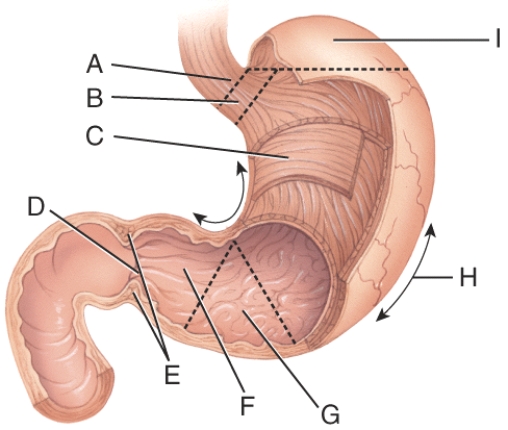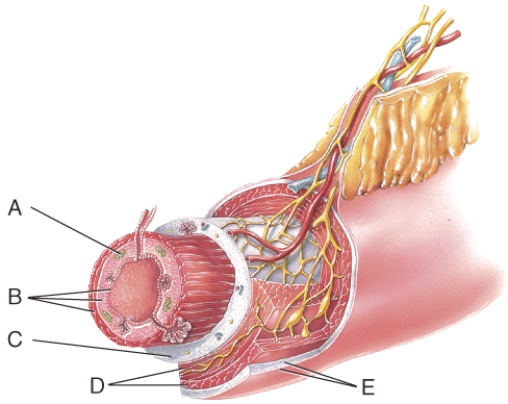A) greater omentum
B) falciform ligament
C) lesser omentum
D) mesentery
E) mesocolon
Correct Answer

verified
Correct Answer
verified
Multiple Choice
This layer of the GI tract is composed of areolar connective tissue that binds the mucosa to the muscularis.
A) submucosa
B) lamina propria
C) epithelium
D) serosa
E) None of these answer choices are correct.
Correct Answer

verified
Correct Answer
verified
Multiple Choice
This major duct carries a fluid rich in bicarbonate ions.
A) pancreatic duct
B) hepatopancreatic duct
C) cystic duct
D) bile duct
E) hepatic duct
Correct Answer

verified
Correct Answer
verified
Multiple Choice
Which of the following secrete hydrochloric acid?
A) mucous cells
B) parietal cells
C) chief cells
D) serosa cells
E) chyme cells
Correct Answer

verified
Correct Answer
verified
Multiple Choice
Which of the following pancreatic enzymes acts on peptide bonds?
A) chymotrypsin
B) amylase
C) pepsin
D) phosphatase
E) nucleosidase
Correct Answer

verified
Correct Answer
verified
Multiple Choice
Duodenal glands
A) secrete an acidic mucous.
B) secrete an alkaline juice.
C) secrete an alkaline mucous.
D) secrete an acidic juice.
Correct Answer

verified
Correct Answer
verified
Multiple Choice
Antioxidant vitamins
A) are found in plasma membranes.
B) are vitamin derivatives.
C) can inactivate oxygen free radicals.
D) are all excreted in feces.
E) are all stored in adipose cells.
Correct Answer

verified
Correct Answer
verified
Multiple Choice
What does line G point to? 
A) pylorus
B) pyloric sphincter
C) rugae
D) pyloric antrum
E) greater curvature
Correct Answer

verified
Correct Answer
verified
Multiple Choice
This is the heaviest gland of the body.
A) heart
B) liver
C) pancreas
D) large intestine
E) thyroid
Correct Answer

verified
Correct Answer
verified
Multiple Choice
What is line D pointing to? 
A) lumen
B) MALT
C) mucosa
D) submucosa
E) muscularis
Correct Answer

verified
Correct Answer
verified
Multiple Choice
Which of the following processes is the function of the smooth muscle layer of the digestive system?
A) ingestion
B) secretion
C) mixing and propulsion
D) absorption
E) None of these choices.
Correct Answer

verified
Correct Answer
verified
Multiple Choice
Ketone bodies
A) can enter the Krebs cycle.
B) are used for ATP production.
C) can be used to make lipids.
D) can enter Krebs or be used for ATP production.
E) convert into aldehydes in the liver.
Correct Answer

verified
Correct Answer
verified
Multiple Choice
This cell secretes the hormone that promotes production of hydrochloric acid.
A) neck cell
B) chief cell
C) enteroendocrine cell
D) chyme cell
E) mucous cell
Correct Answer

verified
Correct Answer
verified
Multiple Choice
This plexus is located between the longitudinal and circular smooth muscle layers of the muscularis.
A) ENS
B) myenteric plexus
C) submucosal plexus
D) digestive plexus
E) absorption plexus
Correct Answer

verified
Correct Answer
verified
Essay
Which vitamins are considered "antioxidant vitamins?" Why is this role so important?
Correct Answer

verified
Vitamins C, E, and beta carotene (a prov...View Answer
Show Answer
Correct Answer
verified
View Answer
Essay
Describe the structural characteristics of the small intestine that enhance its function as the major absorber of nutrients.
Correct Answer

verified
All structures increase surface area to ...View Answer
Show Answer
Correct Answer
verified
View Answer
Multiple Choice
This is the principle bile pigment.
A) stercobilin
B) bilirubin
C) biliverdin
D) both stercobilin and bilirubin
E) All of these answer choices are correct.
Correct Answer

verified
Correct Answer
verified
Multiple Choice
Where does the Kreb's cycle take place?
A) cytosol
B) plasma membrane
C) nucleus
D) mitochondria
E) golgi apparatus
Correct Answer

verified
Correct Answer
verified
Multiple Choice
Most glucose that enters the liver is converted to
A) pyruvic acid.
B) glycogen.
C) amino acids.
D) insulin.
E) glucose.
Correct Answer

verified
Correct Answer
verified
Essay
Identify the different types of lipoproteins and describe the function of each.
Correct Answer

verified
Chylomicrons transport dietary lipids in...View Answer
Show Answer
Correct Answer
verified
View Answer
Showing 21 - 40 of 75
Related Exams